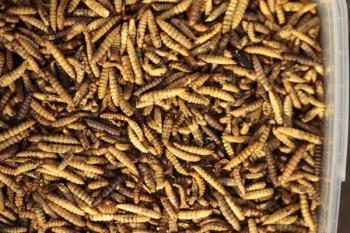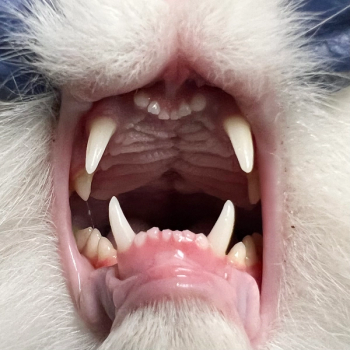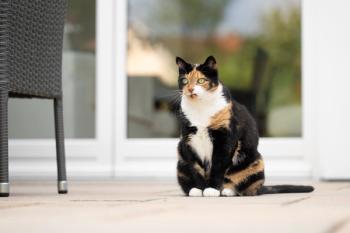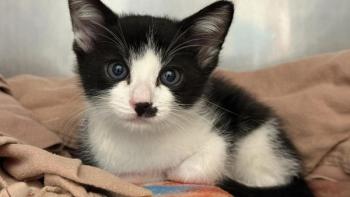
Clinical Exposures: Horner syndromeAn esophagostomy tube placement complication
This case shows that while nutritional support is vitally important, care must be shown to avoid neurological complications.
A 12-year-old, 5.8-kg, female spayed domestic shorthaired cat was presented to Red Bank Veterinary Hospital in Tinton Falls, New Jersey, for evaluation of a three-week history of hyporexia that progressed to anorexia. The patient had a history of diabetes mellitus diagnosed one year prior to presentation. The diabetes was reportedly well controlled with porcine insulin zinc suspension (Vetsulin-Merck Animal Health) with 1 U administered subcutaneously every 24 hours. However, insulin had not been administered for three weeks prior to presentation due to hyporexia. Initial physical and neurological examinations were normal with the exception of obesity (body condition score of 8/9) and an unkempt haircoat.
Diagnostic testing
Initial diagnostics included a complete blood count (CBC), serum chemistry profile, urinalysis, urine culture and sensitivity and abdominal ultrasound. The CBC results were within normal limits. The serum chemistry profile revealed elevated alkaline phosphatase activity (252 U/L; reference interval = 14-111 U/L), hyperbilirubinemia (1.6 mg/dl; reference interval = 0-0.9 mg/dl) and hypokalemia (3.3 mmol/L; reference interval = 3.5-5.8 mmol/L). The blood glucose concentration was normal at 116 mg/dl (reference interval 71-159 mg/dl). Abdominal ultrasonography revealed a diffusely and markedly hyperechoic liver with subjectively enlarged and rounded margins. Additionally, there were hyperechoic foci in the renal pelvic recesses compatible with mineralization or small calculi. A urinalysis revealed ketonuria, hematuria, proteinuria and bilirubinuria with a urine specific gravity of 1.060. Urine culture revealed no aerobic bacterial growth. A urine protein/creatinine ratio was 0.3 (reference interval < 0.5).
Serial evaluation of serum chemistry profiles over three days revealed progressive hyperbilirubinemia (1.9, 2.4 and 3.1 mg/dl). A gastrointestinal panel revealed elevated trypsin-like immunoreactivity (83.90 µg/L; reference interval = 12-82 µg/L), elevated feline specific pancreatic lipase (SPEC fPL) activity (50 µg/L; reference interval = 0-3.5 µg/L) and normal cobalamin (871 ng/L; reference interval = 276-1,425 ng/L) and folate (10.1 µg/L; reference interval = 8.9-19.9 µg/L) concentrations. Serum ketones using Keto Diastix (Bayer) were negative.
Ultrasonographic and serum biochemical results were suggestive of hepatic lipidosis, suspected to be secondary to pancreatitis given the elevated SPEC fPL activity; however, primary small intestinal disease such as inflammatory bowel disease or lymphoma was also considered.
Treatment
Initial treatment consisted of intravenous (IV) fluid therapy with lactated Ringer's solution supplemented with 40 mEq potassium chloride/L given at 10 mL/hour as a constant-rate infusion, mirtazapine 1.87 mg orally every 48 hours and maropitant 6 mg IV every 24 hours. Cobalamin was supplemented at 250 µg subcutaneously once.
Because of continued anorexia, an esophagostomy tube (E-tube) was placed for enteral nutritional support. For E-tube placement, the patient was administered ketamine (1.2 mg/kg IV) and buprenorphine (0.01 mg/kg IV), induced with alfaxalone (1.7 mg/kg IV to effect), intubated and maintained with isoflurane. The patient was placed in right lateral recumbency and the left cervical region was clipped and aseptically prepared. A Rochester-Carmalt Forceps was passed perorally into the esophagus, about half way between the ramus of the mandible and the thoracic inlet. The forceps was used to displace the esophagus laterally and dorsally under the skin in order to isolate the esophagus from adjacent neurovascular structures (internal/external jugular veins, common carotid artery, vagosympathetic trunk and recurrent laryngeal nerve). A < 5-mm incision was made through the skin and esophagus over the tip of the forceps using a No. 11 scalpel blade. An 18-Fr Mila E-tube was placed into the jaws of the forceps, and the tube was pulled through the stoma and out of the mouth. The tube was redirected aborad and placed into the distal esophagus. Proper placement of the E-tube was confirmed via endoscopic visualization. The tube was sutured to the skin with two looping stay sutures and a finger trap pattern and a protective bandage was placed around the neck. The procedure was considered routine and the cat recovered uneventfully from the anesthesia.
However, immediately postoperatively, the patient was noted to have miosis, a prolapsed third eyelid, enophthalmos and a narrowed palpebral fissure (ptosis) of the left eye consistent with oculosympathetic paralysis or Horner syndrome (Figure 1).
Figure 1: A 12-year-old domestic shorthaired cat after esophagostomy tube placement. Classic signs of Horner syndrome are present (miosis, elevated third eyelid, narrowed palpebral fissure or ptosis and enophthalmos) in the left eye. Additionally, the left pinna is hyperemic. | All photos courtesy of authors.
The left pinna was hyperemic and warm to the touch compared with the right pinna (Figure 2).
Figure 2: The same cat showing the right (a) and left (b) pinnae. The left pinna is markedly hyperemic compared with the right pinna. The left pinna was also distinctly warmer to the touch than the right pinna.
Using an infrared thermometer, the temperature of the skin on the concave surface of the left pinna and the left side of the face ranged from 9 to 13 F warmer than the right side (Figure 3).
Figure 3: The same cat comparing temperatures of right (a) and left (b) pinnae using an infrared thermometer. The left side of the face and pinna were 9 to 13 F warmer than the right side secondary to sympathetic denervation and vasodilation on the left side.
The patient was subsequently treated with Denamarin (Nutramax Laboratories Veterinary Sciences) 90 mg orally every 24 hours, maropitant 12 mg via E-tube every 24 hours, and mirtazapine 1.87 mg via E-tube every 24 hours. E-tube feedings with blenderized Royal Canin Recovery RS canned food were initiated at 25% of resting energy requirements (RER) divided every six hours and increased daily to achieve 100% RER after four days, as the patient tolerated. After four days of hospitalization, the cat was discharged to the care of the owner with instructions for E-tube feedings and continued administration of Denamarin, maropitant and mirtazapine. At the time of discharge, the Horner syndrome remained.
Although E-tube feedings were tolerated in the hospital, the patient began vomiting at home. Because of a concern for poor quality of life, the owner elected humane euthanasia.
Discussion
Feeding tubes
Nutritional support is important in critically ill small animal patients as malnutrition has been associated with increased morbidity and mortality.1,2 Moreover, early enteral nutrition has been shown to decrease morbidity and mortality in critically ill patients.3 Compared with parenteral nutrition, enteral feeding is a more physiological means of providing nutritional support and should be considered in patients with normal gastrointestinal function. Enteral nutrition can be provided via nasoesophageal, esophagostomy and gastrostomy tubes, each with benefits and drawbacks, which are beyond the scope of this publication.
E-tube feeding is among the most reliable methods of providing enteral nutrition but may be associated with complications.1 Complication rates range between 37-52% in patients during E-tube placement or during use; most complications are considered minor and not life-threatening.3,4 Reported complications include misplacement of the tube in the mediastinum or periesophageal adventitia, damage to neurovascular structures, stoma/tube site infection, regurgitation or vomiting with or without secondary dislodgement of the tube, head shaking and scratching at the tube, clogging of the tube, entanglement with the endotracheal tube during placement and kinking of the tube during or after placement.1,3,4 Swelling of the face and head may occur if the protective neck bandage is wrapped tightly around the neck.4 In one case, the jugular vein was incised inadvertently, but hemorrhage was controlled with gentle pressure to the jugular vein after the tube was removed. Another tube was then placed on the opposite side of the neck without complication in that patient.3
The authors of one technique purport fewer complications associated with the neurovascular structures using a special tube applicator.1 For this technique, the applicator is introduced through the mouth into the esophagus. A skin incision is made over the applicator, the subcutaneous tissue and cervical musculature are bluntly dissected to the esophagus, and a stab incision is made through the esophageal wall over the applicator. A groove in the applicator is used to direct the esophagostomy tube aborally into the esophagus without having to redirect from the oral cavity as with other techniques. The authors of this technique suggest that the bulb of the applicator pushes the neurovascular structures away from the incision site.
Despite the possibility of damage to the neurovascular structures during esophagostomy tube placement, Horner syndrome caused by damage to the vagosympathetic trunk has not previously been reported.
Sympathetic nervous system anatomy
The sympathetic innervation to the eye and head originates in the hypothalamus and rostral midbrain. The axons travel caudally through the brainstem and cervical spinal cord in the lateral tectotegmentospinal tracts to synapse on preganglionic sympathetic neurons in the lateral intermediate substance of the C8 through T7 spinal cord segments (specifically T1 through T3 or T4 spinal cord segments for innervation of the eye). The preganglionic axons exit the spinal cord via the ventral roots and spinal nerves but leave the spinal nerves in the rami communicantes to join the sympathetic trunk. The axons destined for the head and eye travel in the thoracic sympathetic trunk coursing longitudinally in the thorax along the ventrolateral aspect of the first four thoracic vertebrae.
The axons continue cranially in the neck as the cervical sympathetic trunk closely associated with the vagus nerve (vagosympathetic trunk) and common carotid artery in the carotid sheath, located dorsolateral to the trachea. The preganglionic sympathetic axons synapse in the cranial cervical ganglion, located lateral to the pharynx and ventromedial to the tympanic bulla. From the cranial cervical ganglion, the pathway to the orbit and eye is not well defined. The axons may join the tympanic plexus within the tympanic cavity, enter the cranial cavity ventral to the trigeminal ganglion, and join the ophthalmic branch of the trigeminal nerve, which enters the orbit via the orbital fissure.5,6 Other post-ganglionic sympathetic axons destined for the head continue as plexuses along the arteries of the head.5,6 A lesion anywhere along this circuitous pathway could cause Horner syndrome.
Nerve damage
Nerve damage can be classified based on severity. From least to most severe, nerve injuries may be qualified as neurapraxia, axonotmesis or neurotmesis. Neurapraxia is a transient, physiological failure of nerve transmission in the absence of structural damage. With axonotmesis, injury results in disruption of axons, with the endoneurial and Schwann cell myelin sheaths remaining intact. Neurotmesis is a complete severance of all structures of the nerve including the axons, Schwann cells and supporting connective tissue.7 While neurapraxia and axonotmesis may improve with time, neurotmesis is often permanent. Unfortunately, it is often impossible to differentiate between these types of nerve injuries based on physical and neurological exams.
Given the close proximity of the vagosympathetic trunk to the esophagus, it is surprising that neurologic complications from E-tube placement are not encountered more frequently (Figure 4).
Figure 4: Illustration depicting the anatomy for E-tube placement. The cat is in right lateral recumbency and a Rochester-Carmalt Forceps has been passed through the mouth into the esophagus, halfway between the ramus of the mandible and the thoracic inlet. The forceps is used to elevate the esophagus dorsally and laterally under the skin. An incision is made through the skin and into the esophagus. Note the proximity of the common carotid artery, internal jugular vein and vagosympathetic trunk to the esophagus and the incision.
In the present case, the degree of damage to the sympathetic trunk is uncertain. In the case of a neurapraxia, it would be expected that the Horner syndrome could resolve within one to two months, whereas with neurotmesis or axonotmesis, the Horner syndrome would likely be permanent. Unfortunately, the cat was euthanized soon after E-tube placement.
Sympathetic denervation
In addition to the well-recognized clinical signs associated with Horner syndrome, erythema and elevated skin temperature associated with the external ear and face on the ipsilateral side also reflected loss of sympathetic innervation. Sympathetic innervation provides for vasoconstriction of blood vessels. Therefore, acute sympathetic paralysis results in peripheral vasodilation and consequent erythema and elevated skin temperature. Other signs of sympathetic paralysis to the head may include decreased nasal air flow due to vasodilation and increased nasal tissue rigidity, as well as increased nasal gland secretion secondary to disinhibition. As a result, nasal congestion can occur and a dry, crusted secretion may accumulate inside the naris.6 This is in contrast to the nasal planum hyperkeratosis that can be seen with parasympathetic denervation to the seromucinous glands of the nasal mucosa.6 The latter is often seen concurrently with facial nerve paralysis.
Summary
Esophagostomy tube placement is commonplace in veterinary medicine to provide enteral nutrition support for a variety of disease processes, both in a general and specialty practice setting. Despite concerns about neurovascular injury during E-tube placement, Horner syndrome has not been previously been reported in the veterinary literature. General practitioners and specialists alike should be aware of the sequelae of sympathetic paralysis to the head including vasodilation, erythema and nasal congestion in addition to the oculosympathetic paralysis. Unfortunately, the patient in this report did not survive long enough to allow recovery from a neurapraxia injury and a postmortem examination was not allowed to determine the cause and extent of injury to the cervical sympathetic nerve.
References
1. von Werthern CJ, Wess G. A new technique for insertion of esophagostomy tubes in cats. J Am Anim Hosp Assoc 2001;37:140-144.
2. Crowe DT, Jr, Downs MO. Pharyngostomy complications in dogs and cats and recommended technical modifications: experimental and clinical investigations. J Am Anim Hosp Assoc 1986;22:493-503
3. Crowe DT, Jr, Devey JJ. Esophagostomy tubes for feeding and decompression: clinical experience in 29 small animal patients. J Am Anim Hosp Assoc 1997;33:393-403.
4. Levine PB, Smallwood LJ, Buback JL. Esophagostomy tubes as a method of nutritional management in cats: a retrospective study. J Am Anim Hosp Assoc 1997;33:405-410.
5. Evans HE, de Lahunta A. The autonomic nervous system. In: Evans HE, de Lahunta A, eds. Miller's Anatomy of the Dog. 4th ed. St. Louis, Missouri: Elsevier Saunders, 2013;575-588.
6. de Lahunta A, Glass EN, Kent M. Lower motor neuron: General visceral efferent system. In Veterinary Neuroanatomy and Clinical Neurology. 4th ed. St. Louis, Missouri: Elsevier Saunders, 2015;197-221.
7. Gemmill TJ, McKee WM. Monoparesis and neurological causes of lameness. In Platt SR, Garosi LS, eds. Small Animal Neurological Emergencies. Boca Raton, Florida: CRC Press, 2012;299-315.
Drs. Joshua D. Warren, Eric N. Glass, Rachel Song and Elizabeth S. Orcutt practice at Red Bank Veterinary Hospital in Tinton Falls, New Jersey. Dr. Marc Kent practices at the University of Georgia School of Veterinary Medicine.
Newsletter
From exam room tips to practice management insights, get trusted veterinary news delivered straight to your inbox—subscribe to dvm360.






